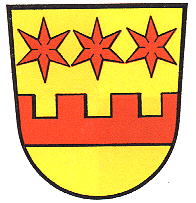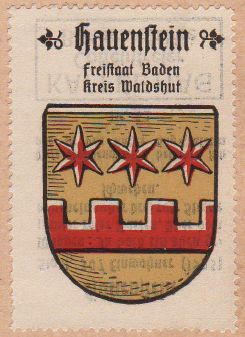Hauenstein (Laufenburg): Difference between revisions
Jump to navigation
Jump to search
Knorrepoes (talk | contribs) No edit summary |
Knorrepoes (talk | contribs) No edit summary |
||
| Line 19: | Line 19: | ||
Hauenstein received city rights in 1317 and was until 1805 a possession of the Dukes (later Emperors) of Austria.<br/> | Hauenstein received city rights in 1317 and was until 1805 a possession of the Dukes (later Emperors) of Austria.<br/> | ||
The arms are derived from the arms of the Lords of Hauenstein from the early 14<sup>th</sup> century. The arms were devised in the beginning of the 20<sup>th</sup> century, as the city never used its own seals. | The arms are derived from the arms of the Lords of Hauenstein from the early 14<sup>th</sup> century. The arms were devised in the beginning of the 20<sup>th</sup> century, as the city never used its own seals. | ||
{|align="center" | |||
|align="center"|[[File:hauenstein.hagd.jpg|center]] <br/>The arms in the [[Kaffee Hag albums]] +/- 1925 | |||
|} | |||
[[Literature]] : Stadler, 1964-1971, 8 volumes; Huber, 1982 | [[Literature]] : Stadler, 1964-1971, 8 volumes; Huber, 1982 | ||
Revision as of 07:37, 9 November 2013
| Heraldry of the World Civic heraldry of Germany - Deutsche Wappen (Gemeindewappen/Kreiswappen) |
HAUENSTEIN
State : Baden-Württemberg
District (Kreis) : Waldshut (until 1973 Säckingen)
Incorporated into : 1972 Laufenburg
Official blazon
In Gold ein erniedrigter, oben gezinnter roter Balken, darüber drei sechsstrahlige rote Sterne nebeneinander.
Origin/meaning
Hauenstein received city rights in 1317 and was until 1805 a possession of the Dukes (later Emperors) of Austria.
The arms are derived from the arms of the Lords of Hauenstein from the early 14th century. The arms were devised in the beginning of the 20th century, as the city never used its own seals.
| The arms in the Kaffee Hag albums +/- 1925 |
Literature : Stadler, 1964-1971, 8 volumes; Huber, 1982


